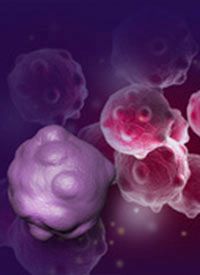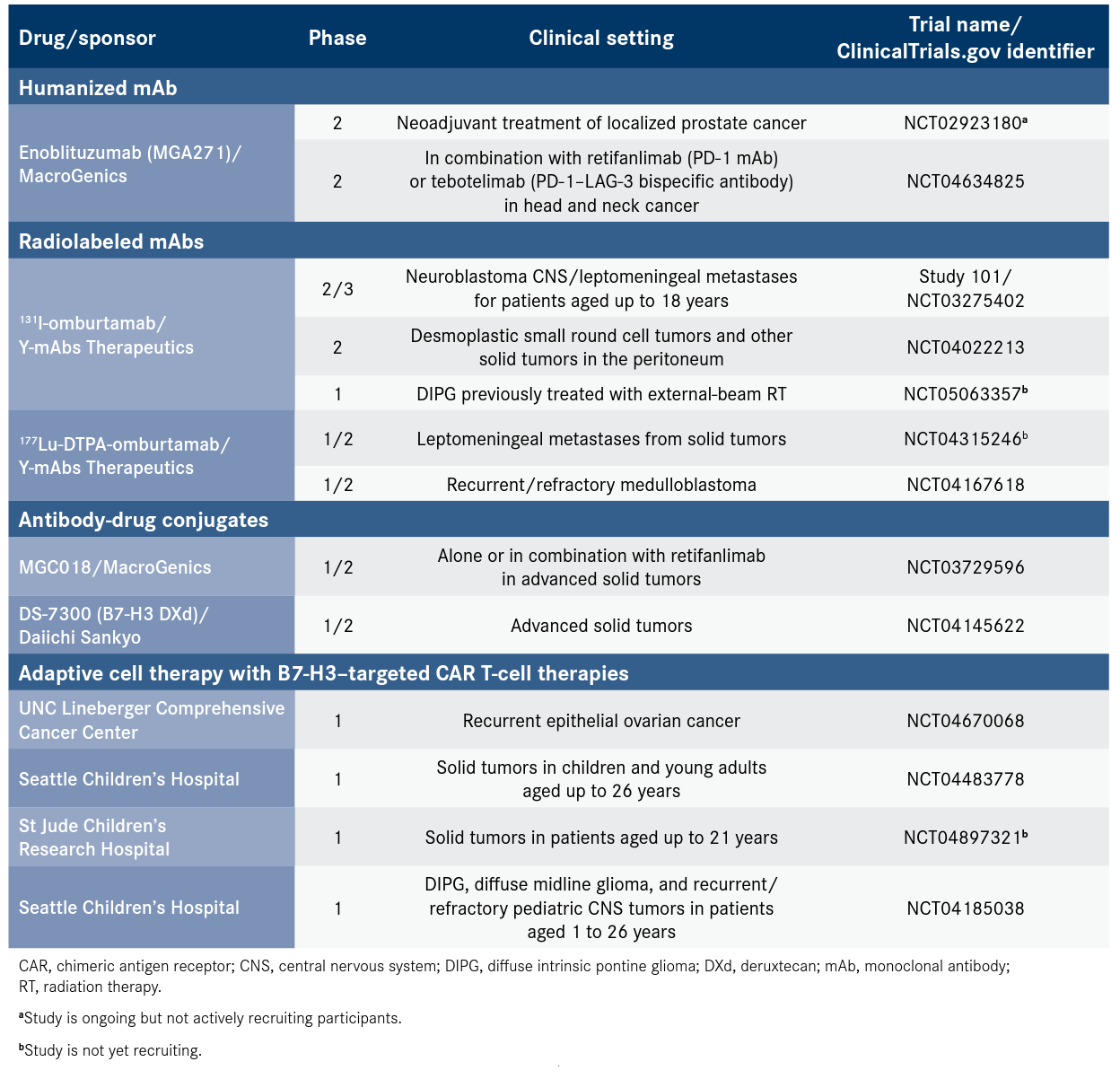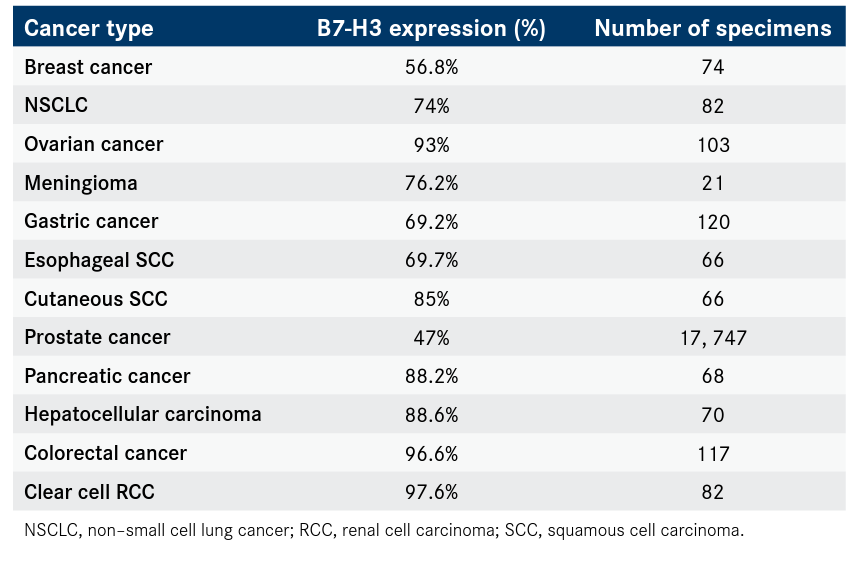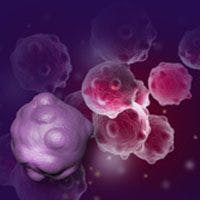Publication
Article
Oncology Live®
Early Data Make B7-H3 a Checkpoint Contender in Prostate Cancer and Beyond
Author(s):
B7-H3, a member of the same protein family as PD-L1, has garnered attention as one of a slew of alternative targets riding the wave of success of immune checkpoint inhibitors in cancer immunotherapy.

B7-H3, a member of the same protein family as PD-L1, has garnered attention as one of a slew of alternative targets riding the wave of success of immune checkpoint inhibitors (ICIs) in cancer immunotherapy.1 Also known by the name of the CD276 gene that encodes the protein, B7-H3 has costimulatory and coinhibitory functions in the immune system that investigators are trying to leverage for new therapies.1
However, although B7-H3 is overexpressed in a range of cancer types,1 clinical development of drugs targeting the protein has been challenging. So far, the pipeline frontrunner has been omburtamab, a B7-H3 monoclonal antibody (mAb) radiolabeled with iodine 131 (131I-omburtamab). The agent demonstrated promise in pediatric patients with central nervous system (CNS) or leptomeningeal metastases from neuroblastoma but faltered in 2020 when the FDA refused to review a biologics license application (BLA) for the drug and instead requested additional information.2 Other B7-H3–targeted drugs also have failed to find their footing in clinical development.3
Nevertheless, investigators continue to explore omburtamab along with other novel strategies directed at B7-H3 activity (Table 1). Y-mAbs Therapeutics, Inc, the company developing omburtamab, is testing several versions of the drug using different radioisotopes.4 Company representatives met with FDA officials in January 2022 and plan to resubmit the application for 131I-omburtamab this year.2
Table 1. Clinical Development of B7-H3–Targeted Therapies

Meanwhile, antibody-drug conjugates (ADCs) that target B7-H3 are generating early excitement among investigators in prostate cancer, which has been largely unresponsive to currently approved ICIs.5 MGC018 and DS-7300 both demonstrated promising clinical activity in patients with metastatic castration-resistant prostate cancer (mCRPC), according to data from ongoing phase 1/2 clinical trials presented at recent conferences.6,7 The antibody enoblituzumab (MGA271) also recently showed promise in a phase 2 study (NCT02923180) in the neoadjuvant setting in patients with resectable prostate cancer.8
Several other B7-H3–targeted drugs are in clinical development across a range of cancer types, including naked antibodies and chimeric antigen receptor T-cell therapies.9,10
B7-H3: An Alternative Checkpoint
During the past 20 years, immunotherapy has cemented its place as the fourth pillar of cancer care.11 In particular, ICIs targeting the PD-1 receptor and its ligands have proved highly effective in numerous cancer types.12
Immune checkpoints are cell-surface receptors and their ligands that provide a secondary signal to T cells primed by antigen recognition. This secondary signal is either stimulatory or inhibitory, resulting in full activation or anergy, respectively, of the T cell. Cancer cells can co-opt the inhibitory signals in order to dampen the antitumor immune response. ICIs are mAbs that target coinhibitory receptors and ligands, such as PD-1 and PD-L1, and are designed to reinstate that immune response.13
Despite the success of ICIs, only a minority of patients benefit; finding ways to broaden these agents’ efficacy has become a central goal of ongoing research.12,14 To that end, other immunoregulatory proteins have become drug targets. Among them is B7-H3, a peripheral membrane protein that shares sequence homology with PD-L1 and has been shown to have similar T cellinhibitory activity.1,9,15
The cellular roles of B7-H3 are still incompletely characterized. Importantly, however, B7-H3 protein expression is limited in normal tissues, whereas it is highly expressed across numerous tumor types, including breast, lung, ovarian, gastric, liver, and kidney cancer (Table 215-26). Notably, B7-H3 is highly expressed in tumor types that display low or no PD-L1 expression in which ICIs have not gained a foothold, such as prostate cancer.8,9,15
Table 2. B7-H3 Protein Expression Across Cancer Types15-26

In one of the largest studies of B7-H3 expression, more than 17,000 prostate cancer specimens were analyzed. B7-H3 protein expression was observed in 47% of tumors, with moderate and strong expression in 21.1% and 13.5% of samples, respectively. High levels of B7-H3 expression were associated with advanced pathological tumor stage, higher Gleason score, lymph node metastasis, high Ki67 labeling index, and early prostate-specific antigen (PSA) recurrence (P < .0001 each).16
B7-H3 is expressed in both localized and metastatic prostate cancer, although high levels of expression are more common in the latter.27,28 Additionally, B7-H3 expression is observed in both castration-sensitive and castration-resistant metastatic disease, with no significant change in expression as tumors progress from one state to the other.29
Omburtamab: A Push for Regulatory Approval
Omburtamab, a murine IgG1-based mAb that specifically targets B7-H3, has been developed as a carrier for radioimmunotherapy.9 Conjugating the antibody to a radioactive isotope allows for more precise delivery of radioactivity to B7-H3 expressing cancer cells, with the aim of reducing systemic toxicity.8 Investigators are pairing omburtamab with 131I, iodine 124, or lutetium 177 in phase 1 and 2 clinical trials.4
131I-omburtamab demonstrated efficacy for the treatment of patients with neuroblastoma involving CNS/leptomeningeal metastases in 2 trials: the phase 2/3 study 101 (NCT03275402) and the phase 1 study 03-133 (NCT00089245). Results from these trials have not yet been published; however, according to data released by Y-mAbs Therapeutics, among 107 evaluable patients who received 131I-omburtamab in the 03-133 study, median overall survival (OS) was 50.8 months compared with a historical median OS of approximately 6 to 9 months.2 The FDA granted omburtamab, then known as burtomab, a breakthrough therapy designation for pediatric relapsed or refractory neuroblastoma with CNS or leptomeningeal metastasis in 2017.30
Based on results from both studies, Y-mAbs Therapeutics submitted a BLA to the FDA in August 2020,31 but shortly thereafter received a “refusal to file” letter. The agency cited the need for further detail in parts of the chemistry, manufacturing, and control module of the BLA, in addition to supplementary clinical trial data, as its reasons for not further reviewing the marketing application.32 The company said it has been working with the FDA to resolve these issues.2
Enoblituzumab: A Naked Antibody Joins the Roster
Advanced Cancers
Enoblituzumab is a humanized B7-H3targeted mAb with an Fc domain that has been engineered to increase its binding to the activating Fcγ receptor and reduce binding to the inhibitory Fcγ receptor to enhance the effector functions of the antibody and optimize antitumor activity.8,33
The agent has been studied in several clinical trials as monotherapy and in combination with the PD-1 inhibitor pembrolizumab (Keytruda) in patients with B7-H3–expressing solid tumors.34,35 Results of a phase 1/2 trial (NCT02475213) published in the Journal for ImmunoTherapy of Cancer showed that dual checkpoint inhibition with enoblituzumab and pembrolizumab elicited antitumor activity and an acceptable safety profile among all treated patients, with notable responses in patients with melanoma, head and neck squamous cell carcinoma (HNSCC), and non–small cell lung cancer (NSCLC).36
In terms of efficacy, the interim analysis showed that patients with ICI-naïve HNSCC (n = 18) or NSCLC (n = 14) derived the most benefit from the combination. The overall response rate (ORR) among patients with HNSCC in this population was 33.3%, with 1 complete response (CR), 5 partial responses (PRs), and 5 patients with stable disease (SD), for a clinical benefit rate (CBR) of 61.1%. The median progression-free survival (PFS) was 3.48 months (95% CI, 1.35-not reached [NR]), with a 6-month PFS rate of 42.1%. The median OS in this patient subset was 17.38 months (9.17-NR), with an estimated 79.9% of patients alive at 6 months.36
Investigators noted that most patients in this group had experienced disease progression following platinum-based chemotherapy and that response rates for this population were higher than what had previously been observed with antiPD-L1 monotherapy.36 In contrast, no patients with HNSCC who had received prior PD-1/PD-L1 therapy (n = 19) had a response to the doublet therapy, but SD was achieved in 47.4% of this group.
Among ICI-naïve patients with NSCLC, the ORR was 35.7%, with all 5 responses being PRs. Notably, 57.1% of patients in this cohort achieved SD, for a CBR of 92.9%. The median PFS was 4.83 months (95% CI, 2.60-12.22), with a 6-month PFS rate of 43.3%. The median OS was 12.32 months (95% CI, 5.65-NR), with an estimated 6-month OS rate of 80.0%.22 Similar to patients who had received prior anti–PD-1 therapy in the HNSCC group, pretreated patients with NSCLC (n = 21) experienced a small benefit with the combination (ORR, 9.5%; SD, 52.4%).36
The trial’s 2 other patient groups, cutaneous melanoma (n = 13) and urothelial cancer (n = 17), were not subdivided by prior treatment status. Despite a low ORR (7.7%) in the cutaneous melanoma group, the median OS was 14.19 months (95% CI, 4.76-NR), with a 6-month OS rate of 78.6%. For patients with urothelial cancer, the ORR, PR rate, SD rate, and CBR were 5.9%, 5.9%, 47.1%, and 59.2%, respectively. The median PFS was 2.18 months (95% CI, 1.28-5.52) in this group, with a 6-month PFS rate of 14.0%. The median OS was 5.72 months (95% CI, 3.09-11.1), with a 6-month OS rate of 47.6%.36
Investigators noted that, unlike other dual-checkpoint blockade regimens, no new safety signals were reported with the combination of enoblituzumab and pembrolizumab and that reported toxicities were comparable to those seen with monotherapy. The authors concluded that the doublet represents a potential chemotherapy-free option for select patients.36
MacroGenics, Inc, is evaluating enoblituzumab in combination with another of the company’s investigational agents, either the PD-1 inhibitor retifanlimab (MGA012) or the PD-1–LAG-3 bispecific antibody tebotelimab (MGD013), in a phase 2 trial in patients with recurrent or metastatic HNSCC (NCT04634825).
Prostate Cancer
At the 2021 European Society for Medical Oncology (ESMO) Congress, results from an ongoing phase 2 trial of enoblituzumab as neoadjuvant therapy in men with operable intermediate-risk to high-risk prostate cancer were presented. Investigators enrolled 32 patients in the trial, who received enoblituzumab intravenously at 15 mg/kg weekly for 6 weeks beginning 50 days before radical prostatectomy. Prostate glands were retained for analysis at the time of radical prostatectomy, 14 days after the final dose of enoblituzumab.10,37
A preprostatectomy reduction in PSA levels of at least 10% was observed in 34% of patients (95% CI, 20%-52%). One year after prostatectomy, 66% of men (95% CI, 48%-80%) had undetectable PSA. Median time to PSA recurrence was not reached (95% CI, 9.4 months-not evaluable). Finally, a reduction in Gleason grade occurred in 50% of patients, whereas 37.5% experienced no grade change and 12.5% saw an increase. Additionally, enoblituzumab treatment led to an apparent change in the tumor microenvironment, with increased infiltration of cytotoxic T cells.10
ADCs: Signs of Efficacy in Prostate Cancer
Several other B7-H3–targeted drugs have demonstrated activity in patients with prostate cancer. MGC018 and DS-7300 are 2 ADCs in clinical development, both consisting of a humanized B7-H3–targeted mAb conjugated to a cytotoxic drug via a cleavable linker.8,38
In MGC018, the cytotoxic agent is the prodrug seco-duocarmycin hydroxybenzamide azaindole (DUBA), an alkylating agent that induces DNA damage. MGC018 has a drug to antibody ratio (DAR) of 2.7, meaning that an average of 2.7 DUBA molecules are carried by each antibody molecule.39
The cytotoxic drug in DS-7300, on the other hand, is the exatecan derivative deruxtecan, a potent topoisomerase inhibitor.38 Deruxtecan has already been successfully deployed as a payload in the FDA-approved HER2-targeted ADC fam-trastuzumab deruxtecan-nxki (Enhertu).40 DS-7300 has a DAR of 4.38 Both drugs are being evaluated in ongoing phase 1/2 dose-escalation and -expansion trials in patients with advanced solid tumors.
MGC018 monotherapy demonstrated a manageable toxicity profile and preliminary antitumor activity in patients with mCRPC and melanoma treated during an ongoing phase 1/2 trial (NCT03729596) in patients with advanced solid tumors, according to findings presented at the 2021 American Society of Clinical Oncology (ASCO) Annual Meeting. In all, 11 of 22 patients with mCRPC treated during dose-escalation and dose-expansion phases experienced a reduction in PSA levels of at least 50%, and 3 of 3 patients with melanoma had PRs with at least 24% reduction in target lesions.41
Dose-expansion cohorts are enrolling patients with several types of relapsed/refractory cancer. Preliminary results for the 40 patients with mCRPC and 21 patients with NSCLC who had been enrolled and treated with the recommended phase 2 dose (3 mg/kg every 3 weeks) at data cutoff (August 2021) were presented at the 2021 ESMO Congress.6
Among 32 patients who were evaluable for response (16 CRPC, 16 NSCLC), 4 patients in each cohort experienced PRs, defined as a reduction in target lesion sums from baseline greater than 30%. Among patients with mCRPC, 39 were evaluable for PSA response, and 53.8% had a reduction in PSA level from baseline greater than 50%.6
The most common treatment-related adverse events (TRAEs) were fatigue, neutropenia, palmar-plantar erythrodysesthesia, pleural effusion, nausea, and asthenia. Grade 3 or higher TRAEs occurred in 50% of patients and 27.9% of patients had at least 1 serious TRAE.6 MacroGenics also plans to test the combination of MGC018 and retifanlimab as part of this trial.
Results from the dose-escalation portion of an ongoing phase 1/2 trial (NCT04145622) of DS-7300 were also presented at the 2021 ESMO Congress. Doses ranging from 0.8 to 16 mg/kg were administered every 3 weeks. Among 56 patients enrolled as of April 2021, there were 9 PRs in patients with mCRPC (3), esophageal squamous cell carcinoma (2), small cell lung cancer (2), squamous NSCLC (1), and endometrial cancer (1); an additional 28 patients experienced SD. There were no dose-limiting toxicities, the only grade 3 or higher TRAE was neutropenia, and there were no serious TRAEs.42
Combined results from the dose-escalation and expansion portions of this trial in patients with mCRPC were reported at the 2022 ASCO Genitourinary Cancers Symposium. As of August 2021, 29 evaluable patients with mCRPC had been treated with DS-7300 monotherapy at doses ranging from 6.4 to 16.0 mg/kg (24 dose escalation and 5 dose expansion). There were 9 PRs (6 confirmed and 3 unconfirmed) and 19 patients had tumor shrinkage for a DCR of 72.4%. Among 19 evaluable patients treated at the dose-expansion level of 12.0 mg/kg, 5 achieved PRs (4 confirmed and 1 unconfirmed).
There were also preliminary indications of improvement in PSA levels and bone metastases. The most common any-grade treatment-emergent AEs were nausea, infusion-related reaction, fatigue, chills, vomiting, anemia, diarrhea, and dehydration, and the most common grade 3 or higher AE event was anemia.7
References
- Flem-Karlsen K, Fodstad Ø, Nunes-Xavier CE. B7-H3 immune checkpoint protein in human cancer. Curr Med Chem. 2020;27(24):4062-4086. doi:10.2174/0929867326666190517115515
- Y-mAbs Therapeutics, Inc. United States Securities and Exchange Commission Form 10-K. Y-mAbs Therapeutics, Inc. Accessed May 9, 2022. https://bit.ly/3KQUwlG
- Taylor P. MacroGenics halts trials of cancer drug after FDA partial hold. Fierce Biotech. December 10, 2018. Accessed April 27, 2022. bit.ly/3kiWYX7
- Our pipeline. Y-mAbs Therapeutics, Inc. Accessed May 9, 2022. https://bit.ly/3wdWln
- Venkatachalam S, McFarland TR, Agarwal N, Swami U. Immune checkpoint inhibitors in prostate cancer. Cancers (Basel). 2021;13(9):2187. doi:10.3390/cancers13092187
- Shenderov E, Mallesara GHG, Wysocki PJ, et al. MGC018, an anti-B7-H3 antibody-drug conjugate (ADC), in patients with advanced solid tumors: preliminary results of phase I cohort expansion. Ann Oncol. 2021;32(suppl 5):S657-S659. doi:10.1016/j.annonc.2021.08.1133
- Patel MR, Johnson ML, Falchook GS, et al. DS-7300 (B7-H3 DXd-ADC) in patients (pts) with metastatic castration-resistant prostate cancer (mCRPC): a subgroup analysis of a phase 1/2 multicenter study. J Clin Oncol. 2022;40(suppl 6):87. doi:10.1200/JCO.2022.40.6_suppl.087
- Liu C, Zhang G, Xiang K, et al. Targeting the immune checkpoint B7-H3 for next-generation cancer immunotherapy. Cancer Immunol Immunother. Published online November 5, 2021. doi:10.1007/s00262-021-03097-x
- Kontos F, Michelakos T, Kurokawa T, et al. B7-H3: an attractive target for antibody-based immunotherapy. Clin Cancer Res. 2021;27(5):1227-1235. doi:10.1158/1078-0432.CCR-20-2584
- Shenderov E, De Marzo A, Lotan T, et al. Phase II neoadjuvant trial of the anti–B7-H3 antibody, enoblituzumab, in men with localized prostate cancer: safety, efficacy and immune correlates. Ann Oncol. 2021;32(suppl 5):S662-S663. doi:10.1016/j.annonc.2021.08.1140
- McCune JS. Rapid advances in immunotherapy to treat cancer. Clin Pharmacol Ther. 2018;103(4):540-544. doi:10.1002/cpt.985
- Robert C. A decade of immune-checkpoint inhibitors in cancer therapy. Nat Commun. 2020;11(1):3801. doi:10.1038/s41467-020-17670-y
- Hargadon KM, Johnson CE, Williams CJ. Immune checkpoint blockade therapy for cancer: an overview of FDA-approved immune checkpoint inhibitors. Int Immunopharmacol. 2018;62:29-39. doi:10.1016/j.intimp.2018.06.001
- Qin S, Xu L, Yi M, Yu S, Wu K, Luo S. Novel immune checkpoint targets: moving beyond PD-1 and CTLA-4. Mol Cancer. 2019;18(1):155. doi:10.1186/s12943-019-1091-2
- Zhou WT, Jin WL. B7-H3/CD276: an emerging cancer immunotherapy. Front Immunol. 2021;12:701006. doi:10.3389/fimmu.2021.701006
- Bonk S, Tasdelen P, Kluth M, et al. High B7-H3 expression is linked to increased risk of prostate cancer progression. Pathol Int. 2020;70(10):733-742. doi:10.1111/pin.12999
- Cong F, Yu H, Gao X. Expression of CD24 and B7-H3 in breast cancer and the clinical significance. Oncol Lett. 2017;14(6):7185-7190. doi:10.3892/ol.2017.7142
- Yonesaka K, Haratani K, Takamura S, et al. B7-H3 negatively modulates CTL-mediated cancer immunity. Clin Cancer Res. 2018;24(11):2653-2664. doi:10.1158/1078-0432.CCR-17-2852
- Zang X, Sullivan PS, Soslow RA, et al. Tumor associated endothelial expression of B7-H3 predicts survival in ovarian carcinomas. Mod Pathol. 2010;23(8):1104-1112. doi:10.1038/modpathol.2010.95
- Proctor DT, Patel Z, Lama S, Resch L, van Marle G, Sutherland GR. Identification of PD-L2, B7-H3 and CTLA-4 immune checkpoint proteins in genetic subtypes of meningioma. Oncoimmunology. 2018;8(1):e1512943. doi:10.1080/2162402X.2018.1512943
- Li Y, Yang X, Wu Y, et al. B7-H3 promotes gastric cancer cell migration and invasion. Oncotarget. 2017;8(42):71725-71735. doi:10.18632/oncotarget.17847
- Varki V, Ioffe OB, Bentzen SM, et al. PD-L1, B7-H3, and PD-1 expression in immunocompetent vs immunosuppressed patients with cutaneous squamous cell carcinoma. Cancer Immunol Immunother. 2018;67(5):805-814. doi:10.1007/s00262-018-2138-8
- Loos M, Hedderich DM, Ottenhausen M, et al. Expression of the costimulatory molecule B7-H3 is associated with prolonged survival in human pancreatic cancer. BMC Cancer. 2009;9:463. doi:10.1186/1471-2407-9-463
- Wang F, Wang G, Liu T, Yu G, Zhang G, Luan X. B7-H3 was highly expressed in human primary hepatocellular carcinoma and promoted tumor progression. Cancer Invest. 2014;32(6):262-271. doi:10.3109/07357907.2014.909826
- Mao Y, Chen L, Wang F, et al. Cancer cell-expressed B7-H3 regulates the differentiation of tumor-associated macrophages in human colorectal carcinoma. Oncol Lett. 2017;14(5):6177-6183. doi:10.3892/ol.2017.6935
- Zhang X, Ji J, Zhang G, et al. Expression and significance of B7-H3 and Tie-2 in the tumor vasculature of clear cell renal carcinoma. Onco Targets Ther. 2017;10:5417-5424. doi:10.2147/OTT.S147041
- Benzon B, Zhao SG, Haffner MC, et al. Correlation of B7-H3 with androgen receptor, immune pathways and poor outcome in prostate cancer: an expression-based analysis. Prostate Cancer Prostatic Dis. 2017;20(1):28-35. doi:10.1038/pcan.2016.49
- Amori G, Sugawara E, Shigematsu Y, et al. Tumor B7-H3 expression in diagnostic biopsy specimens and survival in patients with metastatic prostate cancer. Prostate Cancer Prostatic Dis. 2021;24(3):767-774. doi:10.1038/s41391-021-00331-6
- Guo C, Figueiredo I, Gurel B, et al. B7-H3 as a therapeutic target in prostate cancer. Cancer Res. 2021;81(suppl 13):LB035. doi:10.1158/1538-7445.AM2021-LB035
- Stallard J. FDA grants breakthrough therapy designation to omburtamab for metastatic neuroblastoma. Memorial Sloan Kettering Cancer Center. June 12, 2017. Accessed April 27, 2022. bit.ly/3keouFo
- Y-mAbs announces completion of submission of omburtamab biologics license application to FDA. News release. Y-mAbs Therapeutics, Inc. August 6, 2020. Accessed April 27, 2022. bit.ly/3Lmdd1K
- Y-mAbs provides regulatory update on omburtamab for the treatment of patients with neuroblastoma. News release. Y-mAbs Therapeutics, Inc. October 5, 2020. Accessed April 27, 2022. bit.ly/3kjDjX3
- Enoblituzumab (anti-B7-H3). MacroGenics. Accessed April 27, 2022. bit.ly/3ES0LEh
- Aggarwal C, Joshua A, Ferris R, et al. A phase 1, open-label, dose escalation study of enoblituzumab in combination with pembrolizumab in patients with select solid tumors. Poster presented at: Society for the Immunotherapy of Cancer 33rd Annual Meeting; November 7-11, 2018; Washington, DC. Accessed April 27, 2022. bit.ly/3LD1vA1
- Powderly J, Cote G, Flaherty K, et al. Interim results of an ongoing phase I, dose escalation study of MGA271 (Fc-optimized humanized anti-B7-H3 monoclonal antibody) in patients with refractory B7-H3-expressing neoplasms or neoplasms whose vasculature expresses B7-H3. J Immunother Cancer. 2015;3(suppl 2):O8. doi:10.1186/2051-1426-3-S2-O8
- Aggarwal C, Prawira A, Antonia S, et al. Dual checkpoint targeting of B7-H3 and PD-1 with enoblituzumab and pembrolizumab in advanced solid tumors: interim results from a multicenter phase I/II trial. J Immunother Cancer. 2022;10(4):e004424. doi:10.1136/jitc-2021-004424
- Neoadjuvant enoblituzumab (MGA271) in men with localized intermediate and high-risk prostate cancer. ClinicalTrials.gov. Updated August 24, 2021. Accessed April 27, 2022. https://clinicaltrials.gov/ct2/show/NCT02923180?term=NCT02923180&draw=2&rank=1
- Yamato M, Hasegawa J, Maejima T, et al. DS-7300a, a DNA topoisomerase I inhibitor, DXd-based antibody-drug conjugate targeting B7-H3, exerts potent antitumor activities in preclinical models. Mol Cancer Ther. 2022;21(4):635-646. doi:10.1158/1535-7163.MCT-21-0554
- MGC018 (B7-H3). MacroGenics. Accessed April 27, 2022. bit.ly/3kgr5hQ
- Narayan P, Osgood CL, Singh H, et al. FDA approval summary: fam-trastuzumab deruxtecan-nxki for the treatment of unresectable or metastatic HER2-positive breast cancer. Clin Cancer Res. 2021;27(16):4478-4485. doi:10.1158/1078-0432.CCR-20-4557
- Jang S, Powderly JD, Spira AI, et al. Phase 1 dose escalation study of MGC018, an anti-B7-H3 antibody-drug conjugate (ADC), in patients with advanced solid tumors. J Clin Oncol. 2021;39(suppl 15):2631. doi:10.1200/JCO.2021.39.15_suppl.2631
- Johnson ML, Doi T, Piha-Paul SA, et al. A phase I/II multicenter, first-in-human study of DS-7300 (B7-H3 DXd-ADC) in patients (pts) with advanced solid tumors. Ann Oncol. 2021;32(suppl 5):S583-S585. doi:10.1016/j.annonc.2021.08.1035



























%20(2)%201-Recovered-Recovered-Recovered-Recovered-Recovered-Recovered-Recovered-Recovered-Recovered-Recovered-Recovered-Recovered-Recovered-Recovered-Recovered-Recovered-Recovered.jpg?fit=crop&auto=format)
%20(2)%201-Recovered-Recovered-Recovered-Recovered-Recovered-Recovered-Recovered-Recovered-Recovered-Recovered-Recovered-Recovered-Recovered-Recovered-Recovered-Recovered-Recovered.jpg?fit=crop&auto=format)
